A Dinosaur Dodges Extinction
Geologically speaking, dinosaurs ruled the earth for a brief period. In automotive terms, the same holds true for the traditional sport utility vehicle. But while dinosaurs will never return, SUVs are attempting a comeback.
Autoblog readers all know the history of the American SUV; it started with the Suburban in 1936 when Chevrolet dropped a station wagon body over a truck chassis. Natural selection favored utilitarian characteristics, so the Suburban grew. Other forces were active in the land of Jeep. Their Wagoneer (1963) survived for decades thanks to genes that combined plushness with off-road capabilities. Another variation on the SUV was the unibody Jeep Cherokee XJ (1984), a new phylum that somehow mutated from body-on-frame parents.
Environmental influencers such as cheap gas and low lease rates caused an SUV Cambrian Explosion throughout the 1980s and 90s. Spontaneous parallel genesis occurred at other manufacturers yielding dozens of Darwinian finch-like variations. Then disaster struck. The entire range of SUVs nearly went extinct with the meteoric impact of 2008's financial collapse and a spike in fuel prices. Does the 2011 Dodge Durango represent the rear-wheel drive SUV's last gasp or its reemergence?
Continue reading...
2011 Dodge Durango - Click above for high-res image gallery
Geologically speaking, dinosaurs ruled the earth for a brief period. In automotive terms, the same holds true for the traditional sport utility vehicle. But while dinosaurs will never return, SUVs are attempting a comeback.
Autoblog readers all know the history of the American SUV; it started with the Suburban in 1936 when Chevrolet dropped a station wagon body over a truck chassis. Natural selection favored utilitarian characteristics, so the Suburban grew. Other forces were active in the land of Jeep. Their Wagoneer (1963) survived for decades thanks to genes that combined plushness with off-road capabilities. Another variation on the SUV was the unibody Jeep Cherokee XJ (1984), a new phylum that somehow mutated from body-on-frame parents.
Environmental influencers such as cheap gas and low lease rates caused an SUV Cambrian Explosion throughout the 1980s and 90s. Spontaneous parallel genesis occurred at other manufacturers yielding dozens of Darwinian finch-like variations. Then disaster struck. The entire range of SUVs nearly went extinct with the meteoric impact of 2008's financial collapse and a spike in fuel prices. Does the 2011 Dodge Durango represent the rear-wheel drive SUV's last gasp or its reemergence?
Continue reading...
Photos copyright ©2010 Drew Phillips / AOL
Your author first laid eyes on the present Durango at a Hail Mary press conference held in December 2008 as a precursor to the 2009 Detroit Auto Show. Those were dark days for Chrysler. The press conference was meant to show that even though then-owner Cerberus was incapable of successfully managing Chrysler, there was still energy and passion at the Auburn Hills HQ.
Then head of design, Ralph Gilles, stoically put on one heck of a show as to what the future held for Chrysler. Alongside an early 2011 300 and Dodge Charger, the red Durango styling buck looked rough. The solid body had blacked out windows and wavy body panels. But the proportions were modern compared to the already archaic 2008 Dakota, an SUV whose best days had passed years earlier.
Gilles is now President and CEO of the Dodge Brand and the Senior VP in charge of Design at Chrysler Group LLC. As evidenced in the fully renewed 2011 Chrysler LLC model line, Gilles earned every bit of both titles.
The all-new 2011 Durango shares nothing with the old model. Therefore, forget everything you know about the antiquated truck-based predecessor. In scientific circles, the jump between these two generations would be recognized as macroevolution as opposed to micro.
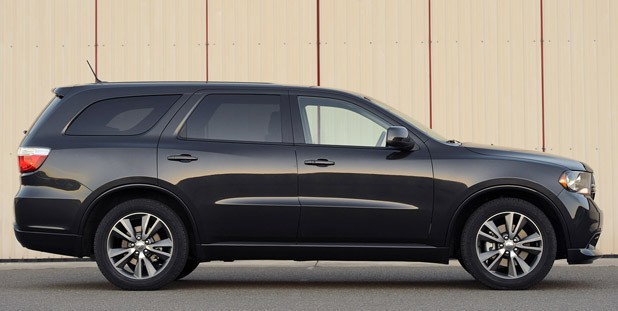
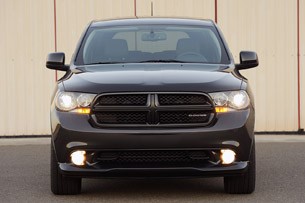
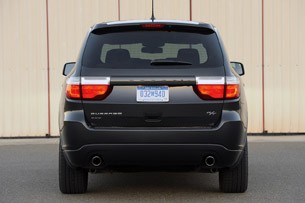
Those looking to trace genes will note a similarity in unibody construction, chassis layout and powertrains between the Durango and Jeep Grand Cherokee. "The Durango and Grand Cherokee were both actually started when Chrysler and Mercedes-Benz were still together. The ML, Grand Cherokee, Durango and next-generation GL all share a common starting point," explains Jack Dolan, Durango's model-responsible engineer.
The result is a three-row, seven-passenger unibody SUV riding on a 119.8-inch wheelbase with four-wheel independent suspension powered by Chrysler's new 3.6-liter Pentastar V6 or the 5.7-liter Hemi V8. (For those looking for a modern comparison point, the new Jeep GC's wheelbase is smaller by five inches and is 10 inches shorter overall.) Properly equipped, the 290-horsepower V6 tows 6,200 pounds and the 360-hp Hemi, 7,400 pounds. Rear-wheel drive is standard, while full-time all-wheel drive an option."While the Dodge and the Jeep were developed together and share much of the same body structure forward of the C-pillar, their characters are much different. At every major juncture, engineers took the Jeep in the direction that maximized off-road capabilities. We optimized the Dodge for the street and meeting the demands of today's SUV buyer," said Dolan. And what does that buyer want? They want the capabilities of a truck-based SUV in terms of towing and cargo hauling in a package that delivers the car-like driving capabilities of a modern crossover.
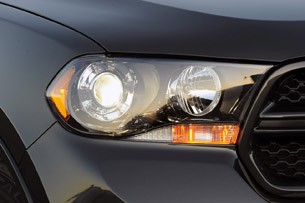
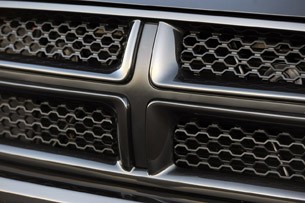
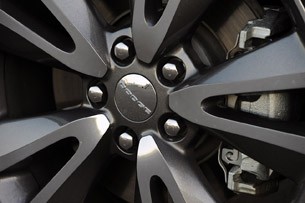
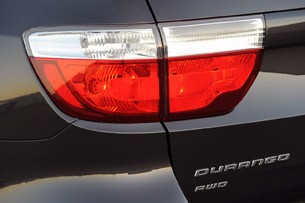
The general package is wrapped in a modern shape that appears athletic, strong and modern. The body sits low over the wheels, and the greenhouse-to-body ratio lowers the roofline further. Gilles and team have refined Dodge's signature crossbar grille to give the new Durango an aggressive look akin to the 2011 Charger. This should come as no surprise once you know that the two vehicles were in the styling studio at the same time. The look is integrated and doesn't appear to be a genetic anomaly.
Inside, the changes are more pronounced. Tired of taking heat for kid-friendly all-plastic interiors (pre-2011 Grand Caravan and Journey), Dodge stylists upped their interior design goals to eclipse even their own well-regarded Ram 1500. The change is dramatic. While not the equal of industry leaders like Audi, the 2011 Durango features large swaths of seamless soft-touch trim panels and cushy surfaces everywhere you're likely to lay a finger.
Attention to detail is especially evident in the gauge cluster and door panels. Glints of chrome highlight the easy-to-read twin-pod gauges. The sweeping shapes on the door panel are accented (depending on model) by various contrasting inserts and deftly molded-in details. We especially appreciated the remote release for the spring-loaded third-row headrests, as the press of that button dramatically improves rear visibility.
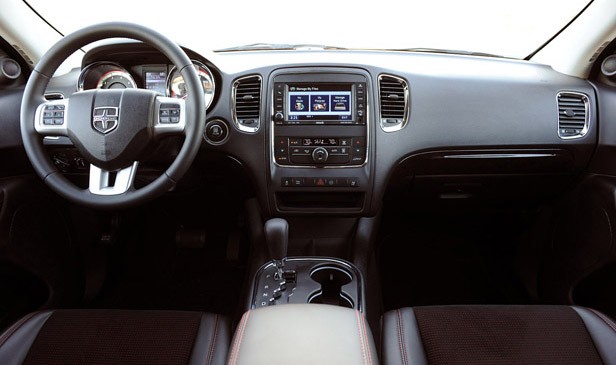
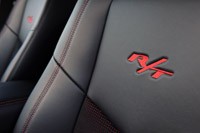

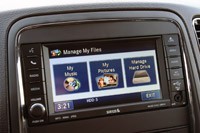
These nuances enhance the fact that the Durango's interior can reportedly be reconfigured 28 ways. We didn't confirm the number, but as you scan our photo gallery, you'll see we tried plenty of different arrangements. With both rear rows stowed, there's room to haul a six-foot sofa with the tailgate closed. Folding all three rows of seats on the passenger-side of the Durango (yes, the right-front seat also folds flat) makes carrying 10-foot 2x4s possible. Maximum cargo room is 84.5 cubic feet – about equal to a Ford Flex, but smaller than a Chevrolet Traverse's 116.4 cubes.
The large rear doors make for easy access to both rear rows. One-touch action on the second-row seat opens a path to the third-row where there's room for a sub-six-foot adult. That adult wouldn't want to spend all day back there, but a neighborhood jaunt won't require chiropractic care.
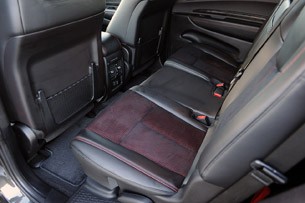
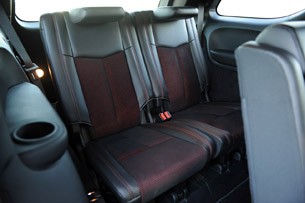
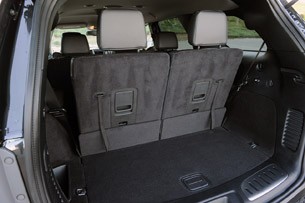
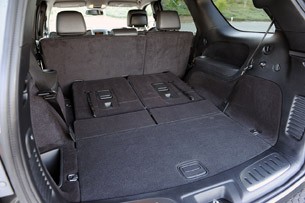
If you're familiar with the 2011 Grand Cherokee, you've got a good idea of what's under the Durango's hood. The base engine is the 3.6-liter V6, Chrysler's new it-goes-in-nearly-everything-we-build engine. Fortunately, it's a pretty good mill. While not rated at over 300+ horsepower like GM's 3.6-liter or Ford's 3.7-liter V6, it delivers 290 horsepower just fine. Like Chrysler's marketing people might have asked themselves, we're wondering why engineers didn't dig a little deeper. Peak torque is 260 pound-feet and fuel economy is 16/23 miles per gallon in RWD spec and 16/22 when driving all four wheels. These numbers will all improve if Fiat's MultiAir heads are fitted to this engine, though engineers remain mum on the prospects.
The V6's mileage figures would have also been better if Chrysler had a RWD transmission with more gears. Strapped for development dollars (a modern transmission requires hundreds of millions to develop), the all-new Durango soldiers on with the old W5A580 five-speed automatic. It could be worse; the 2011 base Avenger still has a four-speed. Chrysler is working on an eight-speed transmission, however, that will debut in some models as early as 2013.
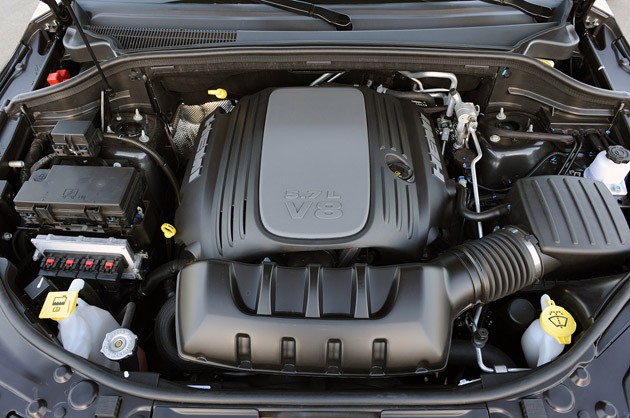
V6 Durango models are available in both RWD and AWD configurations. AWD units get a permanent one-ratio transfer case that begins with an initial torque split of 50:50.
Meanwhile, the legendary Hemi V8 with cylinder deactivation is optional. It cranks out 360 hp and 390 lb-ft torque and is backed by the heavier-duty 545RFE five-speed automatic. RWD and AWD are also both available, but the Hemi's AWD has a low 2.72:1 reduction ratio low range. Additionally, in low, the front and rear prop shafts are locks, helping deliver better power for light off-roading. The Hemi's AWD also includes a Neutral position, enabling flat towing. Mileage is 14/20 for the RWD, and 13/20 for the AWD version.
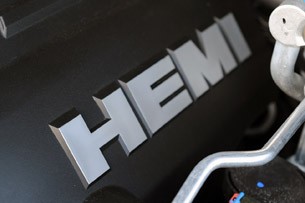
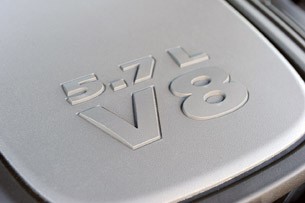
Everything that makes up the 2011 Durango finds itself packaged into four models with new designations; the Express, the Crew, the R/T and the Citadel. Unlike in years past, there is no "base" model. At $29,195, the entry-level Durango Express includes tri-zone automatic climate control, LED ambient lighting, hill-start assist and trailer sway control as standard equipment.
The Crew, at $33,195, is expected to be the volume model. It packages most of the content most buyers want into an easy-to-buy model that adds dozens of features including a power liftgate, proximity key system, power front seats, rear-view camera and an Alpine premium audio system with full media connectivity. The Citadel is the fully-loaded Durango, and at $41,795, it has leather and power everything. Sirius Backseat television, AWD, skid plates, trailer towing equipment and the HEMI V8 are the Citadel's only options.
This leaves us to describe the 2011 Durango R/T. This $32,170 SUV wears a unique front fascia with a deeper front spoiler and a monochromatic look. The R/T specific wheels measure 20-inches and wear P265/50R20 Kumho Solus tires. The body rides 20mm lower, and the rear suspension includes ZF Sachs Nivomat air springs to make sure the Durango can still haul stuff when it's not hauling ass.
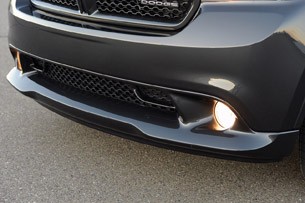

We spent all of our allotted time behind the wheel of an R/T blasting around California's Napa Valley. The performance-oriented SUV is immediately comfortable and easy to drive. The interior is quiet, the seats supportive and all major controls work as designed.
Another characteristic that made itself immediately known was this vehicle's weight. At 5,331 pounds, the AWD R/T feels heavy because it is. The Hemi had to work hard to make the R/T hustle, making us think that driving a V6 Durango might try our patience. (A complete road test will fill in the blanks as soon as these vehicles become available.)
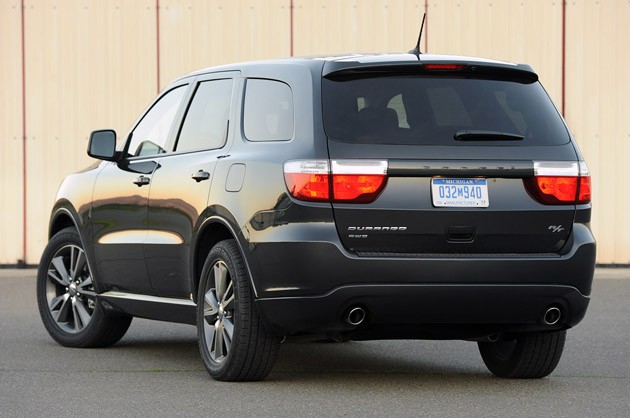
Surprisingly, when the roads got twisty, the Durango's new fully-independent suspension somehow masked at least a thousand pounds. The R/T carved a sharp line through corners. Unlike V6 Durangos that use an electro-hydraulic power steering system, the HEMI R/T uses a standard hydraulic steering rack-and-pinion unit. The feedback and information delivery through the wheel was surprisingly helpful and full of life. This made the R/T genuinely entertaining on roads better suited to a Lotus Elise. The four-wheel disc brakes also kept pace just fine, but we did smell the pads after a particularly long and curvy downhill where we were pushing on.
A previous-generation Durango would have been miserable on the same roads. As would its driver and passengers. The 2011 Durango, however, is no old-school dinosaur, but a new-and-improved breed that Dodge hopes will be the most extinct-proof model to date.
Photos copyright ©2010 Drew Phillips / AOL


Sign in to post
Please sign in to leave a comment.
Continue